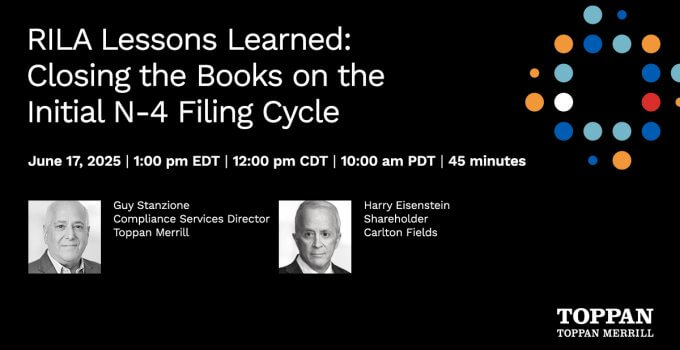Beginning September 23, the SEC will allow Registered Index Linked Annuities (RILAs) to use amended Form N-4 to establish a consistent registration process for all annuity issuers transitioning from Form S-1 and S-3.
RILA filers who converted to Form N-4 recently completed their annual updates and now have a cycle behind them.
Listen in as our RILA experts discussed key takeaways from the initial RILA N-4 post-effective filing season. The session explored regulatory developments, operational insights from the filing cycle, and what to look forward to in 2026.
Topics included:
- SEC comments regarding additional disclosure not in the Form
- Unique product complexities
- SEC filing challenges and trends
- What to look forward to in 2026
Webinar Q&A:
Q1: I have an XBRL Question. If I have a combined RILA and variable annuity contract in one prospectus, does it increase my XBRL requirements.
A: Although you’ll have more items to tag for a combined prospectus to incorporate the requirements for indexed-linked and variable products, the effort will be considerably less than if you had separate prospectuses and had to tag the “common” elements in each.
Q2: You mentioned in the webinar that if we utilize a Summary Prospectus for our RILA once we convert to N-4, we could realize savings by distributing smaller documents. What are the web hosting requirements you mentioned?
A: The SEC adopted web hosting requirements for RILAs, MVAs, and variable products in Rule 498A to support a layered disclosure framework, similar to the one used for open-end mutual funds. When providing a summary prospectus for both existing shareholders and potential investors, more detailed disclosure must be made available on a public website. This framework specifies that the statutory prospectus and Statement of Additional Information (SAI) must be accessible from the summary prospectus within no more than two mouse clicks. In addition, internal document links or hover-text must be created for terms defined in the Special Terms/Definitions section of the Initial Summary Prospectus (ISP) and Updating Summary Prospectus (USP), directing the user to the relevant definition.
Q3: Your comments on changes seem to have been focused on the cover page. Were there any additional disclosures staff were requiring for items that would be included in a summary prospectus?
A: Yes. In some cases, the additional disclosures described in the webinar presentation were also inserted into the Overview and the Key Information Table.
One basic rule for information provided in response to the Overview and the Key Information Table form items (Items 2 and 3, respectively) is that registrants may not add disclosure beyond what is required by those items (General Instruction C.3.b). That said, some elements of these items are sufficiently open-ended that, in certain circumstances, additional disclosures have been added in subsequent filings to provide greater clarity.
For example, the Overview item asks registrants to state “for whom the Contract may be appropriate.” Issuers of products with ongoing deductions were adding language to indicate that investors should consider whether the contract is appropriate for them.
Another example: the Risks section of the Key Information Table asks registrants to state the maximum loss after taking limits on loss into account. In response, registrants were adding language noting that cumulative losses across multiple crediting periods could exceed the limit imposed in any single period.
The takeaway is that registrants planning to register a non-variable product on Form N-4 should carefully consider and respond thoroughly to each element of the form, especially those addressing the risks associated with RILAs or MVAs.
Q4: Has the staff provided any additional guidance on the scope of rate sheet supplements used in connection with RILA filings?
A: No. While we hope staff will consider expanding the terms for which a rate sheet supplement may be used, only numerical terms, such as rates and fees, used in connection with optional benefits are still the only acceptable subjects of a rate sheet supplement.







